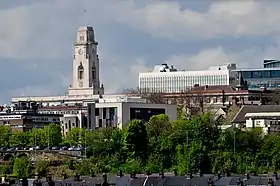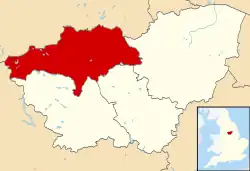Borough of Barnsley | |
|---|---|
 Barnsley, the largest settlement and administrative centre of the borough. | |
 Arms of Barnsley Metropolitan Borough Council | |
 Barnsley Metropolitan Borough shown within South Yorkshire | |
| Sovereign state | United Kingdom |
| Constituent country | England |
| Region | Yorkshire and the Humber |
| Ceremonial county | South Yorkshire |
| Admin. HQ | Barnsley |
| Government | |
| • Type | Barnsley Metropolitan Borough Council |
| • Leadership: | Leader & Cabinet |
| • Executive: | Labour |
| • MPs: | John Healey (Lab.), Dan Jarvis (Lab.), Stephanie Peacock (Lab.), Miriam Cates (Con.) |
| Area | |
| • Total | 127.1 sq mi (329.1 km2) |
| • Rank | 114th |
| Population (2021) | |
| • Total | 244,893 |
| • Rank | Ranked 76th |
| • Density | 1,900/sq mi (740/km2) |
| Time zone | UTC+0 (Greenwich Mean Time) |
| • Summer (DST) | UTC+1 (British Summer Time) |
| ONS code | 00CC (ONS) E08000016 (GSS) |
| Ethnicity | 97.9% White[1] |
| Website | barnsley.gov.uk |
The Metropolitan Borough of Barnsley is a metropolitan borough in South Yorkshire, England; the main settlement is Barnsley and other notable towns include Penistone, Wombwell and Hoyland.
The borough is bisected by the M1 motorway; it is rural to the west, and largely urban/industrial to the east it is estimated that around 16% of the Borough is classed as Urban overall with this area being home to a vast majority of its residents. Additionally 68% of Barnsley's 32,863 hectares is green belt and 9% is national park land, the majority of which is west of the M1. In 2007 it was estimated that Barnsley had 224,600 residents, measured at the 2011 census as 231,221,[2] nine tenths of whom live east of the M1.
The neighbouring districts are Doncaster, Rotherham, Sheffield, High Peak, Kirklees and Wakefield.
History
The borough was created on 1 April 1974 under the Local Government Act 1972. It covered the whole area of 12 former districts and parts of another two, which were all abolished at the same time:[3][4]
- Barnsley County Borough
- Cudworth Urban District
- Darfield Urban District
- Darton Urban District
- Dearne Urban District
- Dodworth Urban District
- Hemsworth Rural District (part, being the parishes of Billingley, Brierley, Great Houghton, Little Houghton and Shafton)
- Hoyland Nether Urban District
- Penistone Rural District
- Penistone Urban District
- Royston Urban District
- Wombwell Urban District
- Worsbrough Urban District
- Wortley Rural District (part, being the parishes of Tankersley and Wortley)
The county borough of Barnsley had been self-governing, whereas the other 13 districts were all lower-tier authorities where county-level services were provided by West Riding County Council.
From its creation in 1974 until 1986, the Metropolitan Borough of Barnsley was a district-level authority, with county-level services provided by South Yorkshire County Council. The county council was abolished in 1986, since when Barnsley has been responsible for all local government services.[5]
The borough forms part of the South Yorkshire Mayoral Combined Authority.
Governance
Elections to the council are held in three out of every four years, with one third of the 63 councillors being elected at each election. The council has been controlled by the Labour Party since its creation in 1974.
The borough council appoints one councillor to be the mayor every year. On the day of the mayor's appointment, a parade takes place in front of the town hall in honour of the new mayor.
Barnsley borough is represented by four MPs: Dan Jarvis for Barnsley Central (Labour), Miriam Cates for Penistone & Stocksbridge (Conservative), Stephanie Peacock for Barnsley East (Labour) and John Healey for Wentworth and Dearne CC (Labour).
Towns, wards and villages
- Ardsley, Athersley
- Barnsley, Barugh, Barugh-Green, Billingley, Birdwell, Bolton upon Dearne, Brierley
- Cortonwood, Carlecotes, Carlton, Cawthorne, Cubley, Cudworth
- Darfield, Darton, Dodworth, Dunford Bridge
- Elsecar
- Gawber, Gilroyd, Goldthorpe, Great Houghton, Grimethorpe
- Haigh (half in Wakefield district), Hemingfield, High Hoyland, Higham, Honeywell, Hood Green, Hoyland, Hoylandswaine
- Ingbirchworth
- Jump
- Kendray, Kexbrough, Kingstone
- Little Houghton, Lundwood
- Mapplewell, Millhouses, Millhouse Green, Monk Bretton
- New Lodge
- Old Town, Oxspring
- Platts Common, Penistone, Pilley, Pogmoor
- Royston, Redbrook
- Shafton, Silkstone, Silkstone Common, Smithies, Staincross, Stairfoot
- Tankersley, Thurgoland, Thurlstone, Thurnscoe
- Ward Green, Wilthorpe, Woolley Colliery, Wombwell, Wortley, Worsbrough
There are many Hoylands in Barnsley – there is the village of Hoyland itself south-east of Barnsley on the road to Sheffield, which includes the former hamlets of Hoyland Common, Upper Hoyland and Hoyland Nether (nether being old English for "lower"). Hoylandswaine is located on the opposite side of the wide valley, and at almost 1000 feet above sea level has a wilder and bleaker feel than High Hoyland. The word Hoyland is derived from Norse, and at its simplest means "farm on a hill". Despite there being countless farms on hills around England, the majority of the Hoylands are concentrated in Barnsley.
Education
There are over 100 schools and colleges in the borough. State education is managed by Barnsley Local Education Authority. There are 14 state-run secondary schools and around 80 primary schools. There was an independent school, Hope House School. Post-16 education is provided at Barnsley College and the sixth form of Penistone Grammar School. An adult education college, Northern College, is located at Wentworth Castle in Stainborough. The University of Huddersfield has a campus in Barnsley town centre.
Places of interest
Places of concern
See also
References
- ↑ "The 2011 Census – Barnsley Council Online". Archived from the original on 30 December 2014. Retrieved 30 December 2014.
- ↑ "Metropolitan District population 2011". Neighbourhood Statistics. Office for National Statistics. Retrieved 3 March 2016.
- ↑ "Local Government Act 1972". legislation.gov.uk. The National Archives. 1972 c. 70. Retrieved 18 June 2023.
- ↑ "The Metropolitan Districts (Names) Order 1973". legislation.gov.uk. The National Archives. SI 1973/137. Retrieved 18 June 2023.
- ↑ "Local Government Act 1985". legislation.gov.uk. The National Archives. 1985 c. 51. Retrieved 18 June 2023.

